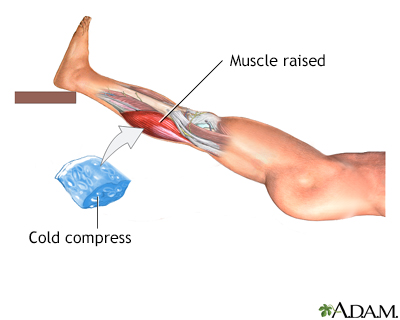Strains
 Print-Friendly
Print-Friendly
Pulled muscle
A strain is when a muscle is stretched too much and part of it tears. It is also called a pulled muscle. A strain is a painful injury. It can be caused by an accident, overusing a muscle, or using a muscle in the wrong way.
I Would Like to Learn About:
Causes
A strain may be caused by:
- Too much physical activity or effort
- Improperly warming up before a physical activity
- Poor flexibility
Symptoms
Symptoms of a strain can include:
- Pain and difficulty moving the injured muscle
- Discolored and bruised skin
- Swelling
First Aid
Take the following first aid steps to treat a strain:
- Apply ice right away to reduce swelling. Wrap the ice in cloth. Do not place ice directly on the skin. Apply ice for 10 to 15 minutes every 1 hour for the first day and every 3 to 4 hours after that.
- Use ice for the first 3 days. After 3 days, either heat or ice may be helpful if you still have pain.
- Rest the pulled muscle for at least a day. If possible, keep the pulled muscle raised above your heart.
- Try not to use a strained muscle while it is still painful. When the pain starts to go away, you can slowly increase activity by gently stretching the injured muscle.
When to Contact a Medical Professional
Call your local emergency number, such as 911, if:
- You are unable to move the muscle.
- The injury is bleeding.
Contact your health care provider if the pain does not go away after several weeks.
Prevention
The following tips may help you reduce your risk for a strain:
- Warm-up properly before exercise and sports.
- Keep your muscles strong and flexible.
Related Information
References
Biundo JJ. Bursitis, tendinitis, and other periarticular disorders and sports medicine. In: Goldman L, Schafer AI, eds. Goldman-Cecil Medicine. 26th ed. Philadelphia, PA: Elsevier; 2020:chap 247.
Geiderman JM, Torbati S. General principles of orthopedic injuries. In: Walls RM, ed. Rosen's Emergency Medicine: Concepts and Clinical Practice. 10th ed. Philadelphia, PA: Elsevier; 2023:chap 41.
Wang D, Eliasberg CD, Rodeo SA. Physiology and pathophysiology of musculoskeletal tissues. In: Miller MD, Thompson SR. eds. DeLee, Drez, & Miller's Orthopaedic Sports Medicine. 5th ed. Philadelphia, PA: Elsevier; 2020:chap 1.



